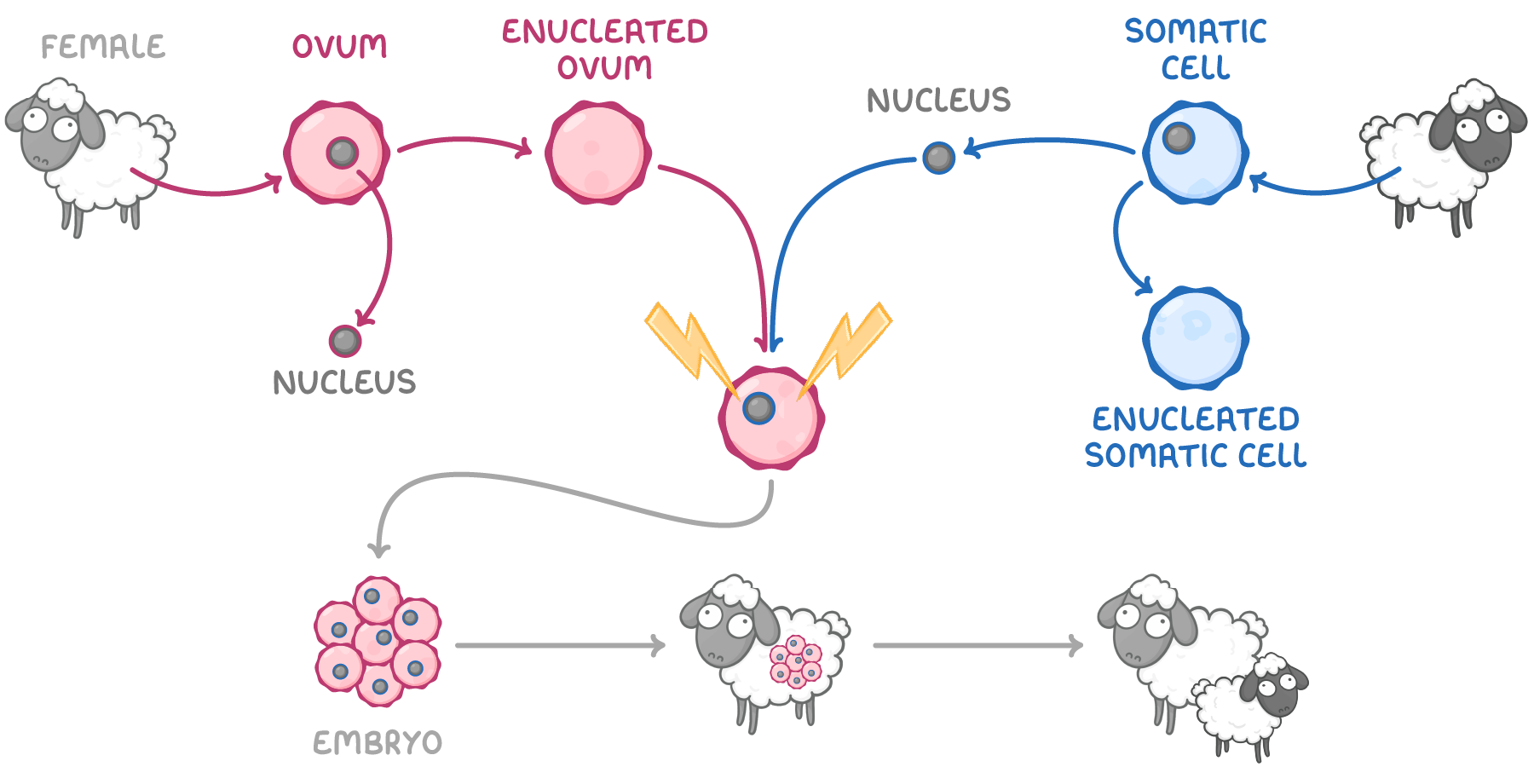Animal Cloning
This lesson covers:
- Natural animal cloning
- Artificial embryo twinning
- Somatic cell nuclear transfer
- Applications of animal cloning
- Arguments for and against the use of animal cloning
Natural animal cloning
Natural cloning occurs when animals produce genetically identical offspring using asexual reproduction.
Natural cloning in invertebrates:
- Some invertebrates undergo regeneration or fragmentation.
- This forms new, genetically identical offspring from parts of their bodies that have broken off.
- e.g. Hydra forms 'buds' that break off the parent organism and grow into new, genetically identical offspring.
Natural cloning in vertebrates:
- This can occur naturally when an early embryo splits into two genetically identical embryos.
- Each embryo grows independently, resulting in genetically identical offspring, known as identical or monozygotic twins.
- e.g. With human identical twins.
Artificial embryo twinning
Artificial embryo twinning is a process in which a single early embryo is manually split, separating its cells before they start to differentiate. This produces multiple identical offspring from a single embryo.
This process of artificial twinning:
- A female organism is treated with hormones to produce multiple ova (egg cells).
- The ova are extracted and fertilised in a Petri dish to produce an embryo.
- The embryo divides into several cells and, while the cells are still totipotent, the embryo is split.
- Each cell is placed into its own Petri dish to develop into individual embryos.
- The embryos are implanted into the uteruses of surrogate mothers for development.
The result is the birth of genetically identical animal clones.
Somatic cell nuclear transfer
Somatic cell nuclear transfer (SCNT) is a process in which a nucleus is transferred from a somatic (body) cell of one animal into an ovum of another animal to form an embryo. This process leads to the development of a clone of the organism from which the nucleus was extracted.

Steps in SCNT:
- A somatic cell nucleus is removed from an adult animal.
- An ovum of a different female animal of the same species is enucleated (the nucleus is removed).
- The nucleus from the somatic cell is transferred into the enucleated ovum.
- The somatic nucleus is fused with the enucleated ovum, often stimulated by an electric shock through electrofusion.
- The fused cell begins dividing, forming an embryo.
- This embryo is implanted into the uterus of a surrogate mother.
- The surrogate eventually gives birth to a clone of the somatic cell donor.
Applications of animal cloning
Animal cloning serves various important purposes.
Some examples of the applications of animal cloning involve:
- Medical research - Cloning produces genetically identical animals for drug testing and disease modelling.
- Conservation - It offers a method to boost the numbers of endangered species from a limited gene pool.
- Agriculture - Cloning can replicate animals with desirable characteristics for selective breeding to improve product quality.
- Pharming - Genetically engineered animal clones can be used to produce therapeutic proteins.
- Stem cells - Cloned embryos provide a source of immunocompatible stem cells for tissue repair.
Arguments for and against animal cloning
The debate over animal cloning technology includes ethical considerations on both sides.
| Arguments for animal cloning | Arguments against animal cloning |
|---|---|
| Ensures the transmission of desirable genetic traits to multiple offspring. | High costs and technically complex. |
| Enables the reproduction of infertile animals. | Reduced genetic diversity increases disease risk. |
| Helps to preserve biodiversity. | Potential for shorter lifespans in clones. |
| Can rapidly increase the population size of certain species. | Ethical concerns regarding the destruction of embryos. |
| Facilitates medical advancements that could alleviate suffering. | Cloned animals often have health issues. |
| SCNT is inefficient, as it can take many ova to produce a single cloned offspring due to high failure rates. |